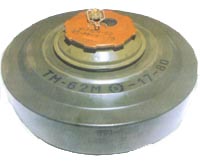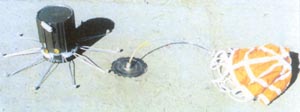The GATOR mine system is a United States military system of air-dropped anti-tank and anti-personnel mines developed in the 1980s to be compatible with existing cluster dispensers. It is used with two dispenser systems—the Navy 230 kg (500 lb) CBU-78/B and the Air Force 450 kg (1,000 lb) CBU-89/B. Additionally the mines are used with the land- and helicopter-based Volcano mine system.

The AT2 mine is a scatterable anti-tank mine developed by Dynamit Nobel. It can be scattered from artillery rockets or from mine laying systems, and was used by the British, German and Norwegian armed forces until the signing of the Ottawa Treaty.

The VS-1.6 is an Italian circular plastic-cased scatterable anti-tank blast mine. It has very few metal components and is resistant to overpressure and shock. The mine can also be deployed conventionally and from helicopters. It was produced by Valsella Meccanotecnica, but production has ceased.

The VS-50 is a circular plastic cased anti-personnel blast mine, formerly manufactured by the now-defunct Valsella Meccanotecnica SpA, an Italian high-tech defence industry specialized in area denial systems which was also the manufacturer of the Valmara 69 and one of the first industries in the world to implement plastic construction for landmines. The design is similar to the TS-50 and VS-MK2 mine. It is blast resistant and can be used in a minimum metal configuration. Though unlikely to kill, the explosive charge contained within a VS-50 is quite sufficient to destroy the victim's foot: the blast is capable of penetrating 5 mm of mild steel leaving an 80 mm-diameter hole.

TM-62 is the designation for a series of Soviet anti-tank blast mines. The mines have a central fuze and typically have a 7.5 kg explosive charge, however they vary greatly in detail. The mines can be laid manually or automatically from a mine laying machine including the PMR-1, PMR-2 wheeled towed mine layers, the GMZ tracked mine laying vehicle and the VMR-2 helicopter mine laying system.
The SB-81 is an Italian plastic cased minimum metal anti-tank blast mine dating from the early 1980s. The mine uses an air pressure based fuze, which gives it protection against overpressure and blast. It can therefore be regarded as a blast resistant mine. The mine can be scattered by hand or by mine laying systems.
The Panzer-Stabmine 43 was a German anti-tank mine, together with the Hohl-Sprung mine 4672 it was the first mine to combine a shaped charge warhead with a tilt-rod fuze. The mine was developed during the Second World War. The mine consisted of a wine glass shaped metal main body mounted on a wooden post, with a tilt rod holding arm projecting to one side. It used a 125 mm diameter warhead with 1.6 kg of explosive, and a combination pressure/tilt fuze.
The VS-AT4 and VS-AT4-EL are Italian minimum metal blast resistant anti-tank blast mines. The VS-AT4 uses a blast-resistant mechanical pressure fuze, while the VS-AT4-EL uses a programmable electronic pressure fuze with an integral anti-lifting function.
ADWAT is a French anti-tank blast mine used with the Matenin mine laying system. The mine has the same casing as the MI AC PR series of mines. The mine has a mechanical and electronic fuze. The mine incorporates a 30-minute arming delay, after which either the electronic or mechanical fuze can trigger the mine. The electronic fuze can be programmed using an external programmer with a three-pin connection to self-neutralize, self-destruct and act as an anti-handling device, with an active period of between one and 365 days.
The Adrushy is an Indian glass-reinforced, plastic-cased anti-tank landmine.

The FFV 028 is a series of steel cased Swedish anti-tank mines that use electronic fuzes. The mines are circular, with a large Misznay Schardin effect warhead in the center of the mine, with the fuzing and sensor electronics located in the dead space above the main charge. The design of the mine dates from the 1970s and uses a magnetic influence sensor to detonate the mine, making it able to attack the full width of armoured vehicles.
The HAK-1 is a Hungarian plastic encased anti-tank mine. It uses a Misznay Schardin effect warhead combined with an electronic acoustic and magnetic influence fuze. The mine can be programmed for an active life of between three hours and 150 days. Once the acoustic sensor detects a target, the magnetic influence sensor is used to detonate the mine at the optimal point. The warhead is capable of penetrating 45 mm of armour and producing a 130 mm diameter hole.
The VS-HCT series of mines are Italian plastic cased anti-tank mines that use Misznay Schardin effect warheads and have a dual seismic and magnetic fuze. The mines are no longer produced and differ in size and shape.

The HPD-1, HPD-2 and HPD-3 are a series of French electrically fuzed anti-tank landmines that use Misznay Schardin effect warheads. The entire series of mines conform to the United States MIL-STD-331.
The MI AC Disp F1 Minotaur mine is a French scatterable anti-tank mine. The mines can also be scattered from 155 millimetre artillery shells, which can hold six of the mines. The mine is cylindrical with two Misznay Schardin effect warheads, one on each side of the mine, with a 600 gram charge. The warhead is claimed to be able to penetrate 90 mm of armour at a distance of 0.5 m. It uses a magnetic influence fuze combined with an anti-handling device which arms itself 64 seconds after launch. At the end of its active life, which is set to between one and 96 hours the mine self-destructs. The land based scattering system can launch mines to a range of up to 300 m.

The MN-111 is a Polish air-dropped anti-tank landmine. The mine is designed for use on soft ground. The mine is cylindrical with six spring-loaded fins attached to one end of the mine, with the cylinder drawn to a point at the opposite end which is topped with a small wind vane. The mine is stored with the fins wrapped round the outside of the mine. Once the mine is dropped from the aircraft the fins spring outward, acting as a drag parachute, slowing the rate of descent to a peak speed of about 60 meters per second. As the mine drops the wind vane spins, generating the power used to arm the mine.

The MN-121 is a Polish scatterable anti-tank mine, externally similar to the German AT-2 mine. The mine is cylindrical with ten wire legs which fold outward to keep the mine upright. The mine uses a magnetic influence fuze, which triggers the mine when a vehicle passes over it. The mine also has an anti-handling device which triggers the mine if it is moved. The mine's warhead is a shaped charge design containing approximately 700 grams of RDX. The manufacturer claims that it is capable of penetrating 60 millimeters of armour at an offset of half a meter.
The MN-123 is a Polish scatterable anti-tank mine. The mine is a flat cylinder, with a bevelled edge. It is normally deployed from a ground vehicle, using a dispensing system holding 80 mines. The mine can also be manually laid. Like the MN-121 mine, it uses a magnetic influence fuze which detects when a vehicle passes over it. It also has an anti-handling device. Both faces of the mine have a Misznay Schardin effect shaped charge, which is reportedly able to penetrate 60 millimeters of armour at an offset of 0.3 meters.

The MPB is a Polish off-route anti-tank mine. It was developed by BELMA with its partner Military Institute of Engineer Technology. The MPB consists of a metal cylinder filled with explosives, mounted horizontally in an adjustable frame. The mine is intended to be hidden from direct view of the intended target, off to the side of a probable vehicle route, usually a road, to attack the weaker armour on the sides and rear of a vehicle. The mine can be triggered by either a contact fuze or an influence fuze based on infra-red and acoustic sensors, and is also fitted with an anti-handling device. When used with the passive infrared fuze, an acoustic sensor detects approaching vehicles and activates the infra-red sensor, which triggers the mine at an optimal moment as the target passes. The mine can be programmed to self-destruct after either 1, 10 or 30 days have passed.
The MSM MK2 is a Finnish belly attack anti-tank mine. The mine has a circular ribbed plastic case that is tapered towards the bottom. It uses an electronic fuze with a combination magnetic and seismic fuze; it also has an anti-handling device. The mine is armed by inserting an arming pin, which completes an electronic circuit. The mine indicates that it is armed by lighting a small LED light which switches off after 10 minutes. When a vehicle approaches, vibrations travelling through the ground trigger the seismic sensor, which activates the magnetic sensor. When a vehicle passes over the mine, the warhead is triggered. First a clearing charge fire, removing up to 100 millimeters of earth from the top of the mine, then a copper-lined Misznay Schardin effect warhead is triggered. This projects a slug of copper at high velocity into the bottom of the target.











